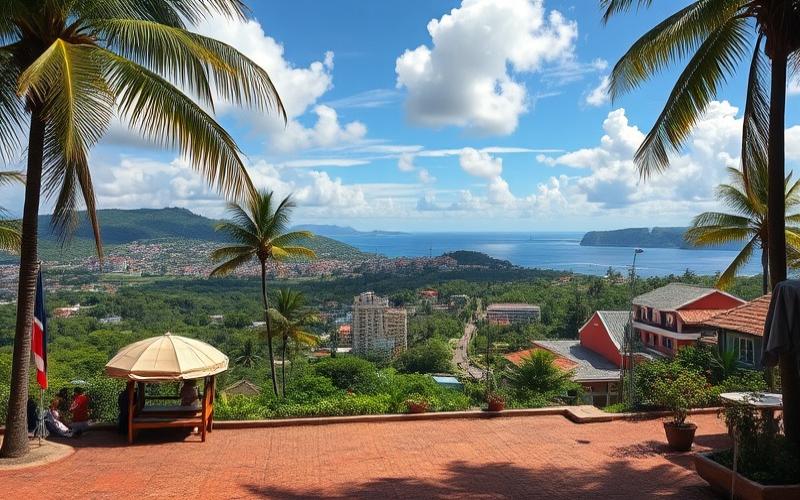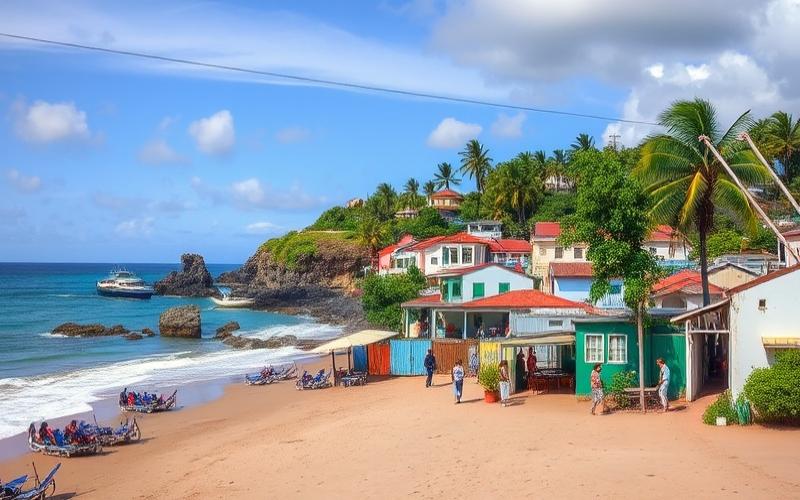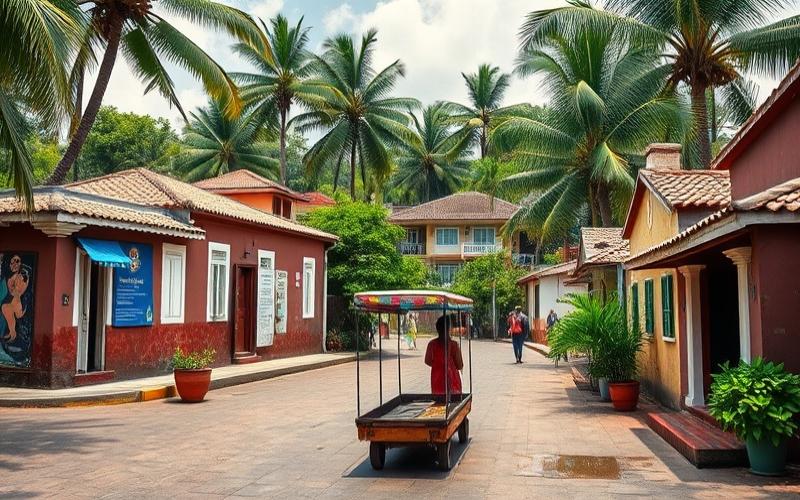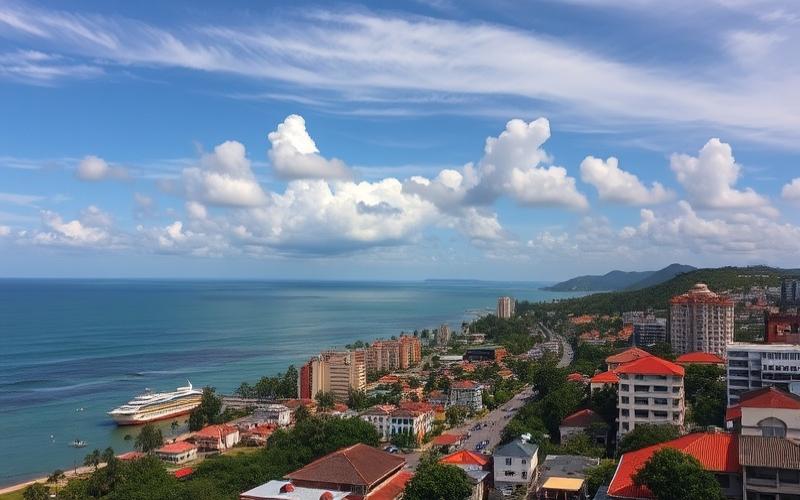
 Published on and written by Cyril Jarnias
Published on and written by Cyril Jarnias
The Dominican Republic, known for its paradise beaches and warm atmosphere, is witnessing the emergence of a new real estate trend: “co-living spaces.” This innovative concept, blending community living and modernity, is increasingly establishing itself as a solution for young professionals and digital nomads seeking a flexible and community-oriented lifestyle. In a rapidly expanding real estate market, these collaborative spaces offer an attractive alternative to share comfortable living quarters and expand social networks.
The Rise of Co-living Spaces Among Youth in the Dominican Republic
The Growing Popularity of Co-living Spaces Among Youth in the Dominican Republic
Co-living is experiencing remarkable growth among young people in the Dominican Republic, attracting students, young professionals, digital nomads, and remote workers. Several factors explain this trend:
- Affordable Cost: Sharing rent and utilities makes living in central neighborhoods more affordable.
- Contract Flexibility: Short-term or flexible leases adapted to uncertain career paths or geographic mobility.
- Desired Community Life: Common areas foster the creation of social and professional networks, essential for quickly integrating into a new city or country.
- Easier Access to Modern Housing: Turnkey offerings with furniture, high-speed internet, and included services.
| Attractiveness Factor | Benefit for Youth |
|---|---|
| Shared Rent | Affordable Housing |
| Flexible Contracts | Easy Adaptation Based on Projects |
| Equipped Common Areas | Modern Comfort Without Extra Cost |
| Community Life | Accelerated Social Integration |
Concrete Benefits of Co-living for Youth
- Increased professional networking opportunities thanks to on-site organized events
- Significant reduction in costs associated with individual housing (rent, internet, maintenance)
- Inclusive access to premium amenities: equipped kitchen, shared gym, coworking space
- Environment conducive to sharing multicultural experiences
Recent Statistics or Case Studies
Although few official local studies are available in 2025 on the precise adoption rate by generation among Dominicans themselves, sustained demand is evident through the continuous development of specialized offerings targeting this segment. International platforms now list the Dominican Republic as a rising co-living destination with notable growth since 2020. The majority of users are aged between 20 and 35.
Economic and Social Factors Favoring the Trend
- Rapid increase in real estate costs in urban centers
- Job market characterized by the rise of freelancing and post-pandemic remote work
- Accelerated urbanization with increased search for flexible solutions among a mobile youth population
Main Drivers:
- Growing difficulty accessing traditional housing
- Increasing desire to join a dynamic community
- Attraction to international/nomadic lifestyle
Challenges Encountered
Non-exhaustive list:
- Sometimes unclear local legislation regarding precise legal status (roommate vs. traditional furnished rental)
- Uncertain economic sustainability: some models struggle against traditional rental competition during low tourist seasons
- Concerns about privacy, especially in heavily shared spaces
Testimonials
“I chose co-living because it not only allowed me to save on my housing budget but also because I wanted to easily meet other people sharing my professional situation.”
— David R., young French digital nomad based near Cabarete
“The international atmosphere is what appealed to me upon arrival. I have access to everything I need without long-term commitment.”
— Maria S., Dominican consultant based in Santo Domingo
Potential Future
The movement is expected to grow under the combined effect of:
- Rapid urbanization,
- Ongoing evolution towards greater professional mobility,
- And increased needs for accessible housing.
However, managing this growth will require a clarified regulatory framework to ensure both economic sustainability AND quality of life for its residents.
Co-living thus appears as an innovative response to current economic challenges faced by Dominican urban youth while catalyzing new social-professional networks in a globalized context.
Good to Know:
Co-living spaces are gaining increasing popularity among youth in the Dominican Republic, attracted by reduced housing costs, networking opportunities, and access to amenities such as gyms and coworking spaces. Studies show that 40% of young professionals choose co-living as a housing solution. This phenomenon is largely supported by a changing job market and rapid urbanization, although risks include legal and privacy concerns. Testimonials indicate that the friendliness and flexibility of co-living spaces are determining factors. Despite challenges, the potential of these spaces to support social and professional integration is promising in a context of growing urbanization.
Upscale shared housing refers to shared accommodation that offers superior comfort and premium services, clearly distinguishing itself from traditional shared housing. These spaces not only offer larger rooms, often with private bathrooms, but also functional and stylish common areas, with particular attention paid to interior aesthetics and furniture quality.
| Traditional Shared Housing | Upscale Shared Housing |
| Basic rooms | Spacious rooms, premium bedding |
| Limited common areas | Large living rooms, modern kitchens |
| Few amenities | Complete appliances (washer/dryer/dishwasher) |
| Rare services | Regular cleaning, concierge |
| Standard internet | Guaranteed fiber optic/high-speed |
Digital professionals – often digital nomads – are particularly attracted to these accommodations for several reasons:
- Environment conducive to productivity thanks to integrated collaborative or private workspaces.
- High level of connectivity (very high-speed internet essential for remote work).
- Community atmosphere fostering exchange between professionals sharing similar values.
- Flexibility in stay duration: possibility to settle for a few weeks or several months without heavy administrative constraints.
Typical amenities include:
- Fiber internet connection or stable high-speed Wi-Fi in all rooms.
- Dedicated coworking spaces: bright shared desks or private rooms for video conferences.
- Included services: weekly cleaning in common and sometimes private areas; quick technical assistance; concierge (taxi/restaurant/event bookings).
- Access to additional facilities: on-site gym or partner subscriptions, integrated laundry, regular organization of social events.
Main Economic and Social Advantages:
- Significant reduction in overall cost compared to an individual apartment with equivalent services.
- Increased professional networking opportunities during internally organized activities.
- Notable improvement in well-being thanks to material comfort and delegated services (cleaning/logistics), allowing residents to focus on their professional activities.
Concrete examples in the Dominican Republic:
| City | Co-living / Shared Housing Space | Key Features |
| Santo Domingo | Casa Nomada | Integrated coworking – international community |
| Punta Cana | The Hive | Private spaces + pool + networking events |
| Las Terrenas | CoWork Paradise | Fiber optic – ocean view – surf/yoga activities |
The rapid rise of upscale shared housing is already transforming the local real estate market. This model attracts a new solvent international clientele that values flexibility and community experience. This trend is expected to intensify with the continuous progression of remote work: we observe increasing diversification of offerings adapted to mobile professionals as well as a qualitative repositioning towards the premium segment by local real estate operators.
***
This evolution energizes the Dominican urban residential economy while stimulating architectural innovation around hybrid spaces between collective housing and professional third places.
Good to Know:
Upscale shared housing distinguishes itself from traditional shared housing through its combination of comfort, services, and integrated design, ideal for digital professionals, often digital nomads, who seek stay flexibility. These spaces offer amenities like high-speed internet access, collaborative or private workspaces, and concierge services, thus meeting the specific needs of these professionals. By choosing upscale shared housing, they benefit from numerous economic and social advantages, particularly in networking and quality of life. Notable examples include Punta Cana’s Co-Living Hub and Santo Domingo’s Digital Nomad Nest, which attract an international community. These shared housing options influence the local real estate market, fostering growing demand for this type of space, thereby increasing these cities’ attractiveness for digital professionals.
The evolution of living and working habits, marked by increased digitalization and the rise of remote work, has profoundly transformed real estate demand in the Dominican Republic. The rise of shared spaces and co-living spaces addresses a dual need: residential flexibility and creation of close-knit communities, particularly for nomadic workers and the digital community.
Social and Technological Factors That Have Favored This Trend:
- Generalization of Remote Work: The democratization of digital tools (video conferencing, collaborative platforms) has allowed professionals to break free from the physical location of their jobs.
- Search for Community and Exchange: Independent workers, freelancers, and digital entrepreneurs seek to break the isolation of working from home by joining environments that foster mutual aid and skill exchange.
- Urban Development and Infrastructure Modernization: Major urban projects, like those in Santo Domingo Este or the revitalization of Puerto Plata’s waterfront, now integrate hybrid living spaces where housing, work, and leisure blend.
- International Openness: The country’s growing attractiveness to expatriates and investors promotes the emergence of multicultural environments conducive to innovation.
Advantages of Co-living Spaces for the Digital Community:
- Facilitated Professional Networking:
- Regular organization of workshops, meetups, and themed events.
- Spontaneous connections between residents from varied sectors.
- Skill Exchange:
- Collaboration on common projects.
- Informal peer learning (sharing best practices, feedback).
- Stimulation of Innovation:
- Environment conducive to creativity thanks to diverse profiles.
- Easier access to shared resources (meeting rooms, equipment, integrated coworking spaces).
- Strengthened Sense of Belonging:
- Creation of rituals and common spaces (shared kitchens, relaxation areas).
- Collective dynamic that fosters mutual aid and well-being.
Summary Table of Co-living Spaces Benefits for the Digital Community:
| Main Advantage | Impact on Digital Community |
|---|---|
| Professional Networking | Accelerates Collaboration Opportunities |
| Skill Exchange | Stimulates Learning and Innovation |
| Residential Flexibility | Facilitates Digital Nomads’ Mobility |
| Sense of Belonging | Strengthens Cohesion and Well-being |
Concrete Examples of Dynamic Co-living Spaces in the Dominican Republic:
- Outsite Cabarete: Located in Cabarete, this space attracts an international community of digital nomads, offering accommodation, shared workspaces, and regular community events.
- Nomad City Las Terrenas: This concept bets on the blend between local life and digital work, with shared villas, coworking spaces, and a program of collaborative workshops.
- Selina Punta Cana: More than a hotel, Selina offers a true living and working ecosystem, integrating accommodation, coworking, wellness space, and networking events.
List of Key Factors Explaining the Success of These Spaces:
- Location in attractive and connected areas.
- Comprehensive service offerings (accommodation, workspaces, social activities).
- Regular community engagement.
- Openness to diverse profiles, fostering rich exchanges.
Co-living spaces are today major catalysts for innovation, networking, and skill exchange in the Dominican Republic, contributing to the vitality and growing attractiveness of the local and international digital community.
Good to Know:
The rise of shared spaces in the Dominican Republic is closely linked to the evolution of lifestyles and work modes, where co-living spaces play a key role in strengthening the digital community. This trend is fueled by social factors, such as the growing desire for flexibility and collaboration, as well as technological innovations facilitating remote work. Co-living spaces, like Casa Linda and The Kite House, offer environments conducive to professional networking and skill exchange, stimulating digital innovation and collaboration. These spaces create dynamic communities where professionals can thrive together, sharing their experiences and expertise while living in a friendly and creative setting.
Disclaimer: The information provided on this website is for informational purposes only and does not constitute financial, legal, or professional advice. We encourage you to consult qualified experts before making any investment, real estate, or expatriation decisions. Although we strive to maintain up-to-date and accurate information, we do not guarantee the completeness, accuracy, or timeliness of the proposed content. As investment and expatriation involve risks, we disclaim any liability for potential losses or damages arising from the use of this site. Your use of this site confirms your acceptance of these terms and your understanding of the associated risks.























































